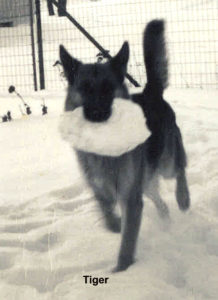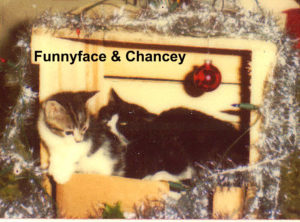I never started out to be a catlady. Probably nobody does. People don’t go to the vocational counsellor to ask what they need to study to be a catlady or catman. And if they did, the counsellor likely wouldn’t know what to answer. But I would say, study the Earth, and the animals, the science and the spiritual traditions that explain how everything is connected.
I grew up with big, furry German Shepherds Dad raised for show.
And many other animals too: budgies, turtles, a bunny, aquarium denizens and various wildlife, sometimes injured, that I brought home. Mother was aghast at the slugs crawling out of my jars and Dad was bitten through his thumbnail by a baby chipmunk I found.
It was in the middle ‘70’s when a fellow student of my husband decided to kill his cat. He’d had a small terrier he couldn’t housebreak and had to give away. He reasoned (? and this was a psychology PhD student) that if he couldn’t have his dog, his wife shouldn’t have her cat. Friends brought chloroform to supper. He’d tried to kill the cat before but didn’t have enough drug and she revived. These are the actions of students who have experimented with cats and electrodes in lab classes. That was Siggie, the first cat I rescued. (SHE was named for Sigmund Freud which should tell you a little more about the student that wanted to kill her.)
In the early ‘80’s, a long way away from such dissociated people, I looked for a feline friend for Siggie and discovered the neighbourhood was full of stray cats. Some came to live with me. The manager of the next-door apartment complex explained how they had a chink in the wall of the furnace room in the parkade, where strays could stay warm and be fed. One of them huddled near a car engine and was injured when the owner started the car. The manager would drip medication on the cat as it ran by her at feeding time.
That was when I found my first feral (wild) cat, Funnyface hiding in the back yard. She had no teeth. I managed to scoop her up (hadn’t yet learned about traps) and took her in. I came home one day to find her newborn 4 kittens all tangled up together in their umbilical cords. The neighbour and I had to cut them apart with scissors. One died in my hand from respiratory disease along with two others. The one that survived I named Chancey.
And people call ME a CRAZY Catlady? All of this was just cleaning up after CRAZY (ie twisted, dissociated) humans.
So that was how it started. I began trapping and taking in strays and ferals. Some were rehomed, some had to be euthanised because they were ill, some stayed with me. I worked with several rescue groups over the years, trapping, helping with fundraising rummage sales, rehoming, seeking veterinary care. And somewhere along the line, I developed my motto:
A Catlady’s Work is Never Done.
Over time, my concept of what was “A Catlady’s Work” expanded. It included other animals besides cats and then whole ecosystems. After all, things affecting other animals and ecosystems could well affect my cats.
I sought care for injured wildlife I happened across. A stray greyhound came up to me at the cash register when I worked in a campground store. People said he had probably been a track dog and such dogs are punished for showing affection. I found him a home. I lived in a wild, forgotten area by the Fraser River and witnessed illegal drywall dumping, pollution and encroaching industrialisation. Not good for my cats or any animals there. I did meditations for healing Earth.
With the internet came information about other so-called “crazy” catladies and rescuers around the world. It also brought all the gory details about the dissociated people hurting the animals. Not just the pets and strays but also the livestock and wildlife. Not just the animals but the Earth itself and its environments. Not just twisted individuals but also corporations and governments dissociated from everything but the bottom line.
Have you noticed how often I’ve used that word “dissociated”? Dissociation happens when details of an event are separated from awareness, emotions like empathy are suppressed/repressed. When a psychology student learns not to consider the terror and pain of the animal he’s sticking electrodes in. When the corporate or governmental decision makers ignore the consequences of destroying habitat and environment. When the doctor/vet/pharmacist gives drugs with health risks. When the computer/TV seems more real than Nature. When the fear of reprisal stops people from standing against the cruelty/destruction of Earth and Earthlings. I’ll say it again: just who is “crazy”, the rescuers or the dissociated humans?
Thing is, it’s deliberate. I asked a young seafood clerk in a grocery store if he didn’t feel sorry for the crabs and lobsters piled on top of each other in the small tank. He said, “you’ve got to get past that”, which was probably an echo of what his boss told him.
Until recently, major religions had viewed animals and Earth as inferior to humans. But that is changing. Now there is a Catholic monastery co-founded by the late Thomas Berry, based on his vision of the Sacred Community of Life including Earth and animals. Sufi Llewellyn Vaughan-Lee, Buddhist Thich Nhat Hanh and Pope Francis are others urging love and care of the Earth.
So these days, “A Catlady’s Work” has expanded to include standing against the dissociation that threatens the whole planet, all the animals (and people) not only my cats. Dr Clarissa Pinkola Estes makes an eloquent case that people living now are “made for these times”. Certainly Earth and animal lovers are desperately needed now. Random acts of kindness are great but they have to get more deliberate and frequent.
Connecting to Earth and Earthlings is the opposite of dissociation. There are many ways to connect. Boots on the ground: take part in rescue and/or activism. From the armchair: support the rescuers, activists, legal fighters with time, money, social and other media.
One can also connect using one’s gifts or passions. I write about cat care. Some knit or crochet nests for animals recovering in rehab. Others write, film (check out Twyla Roscovich, John E. Marriott), or otherwise capture attention using their creativity. And of course, mindfulness about the business practices supported by one’s purchasing, banking and lifestyle, can go a long way toward change.
I would be both dumbfounded and joyous if one day, this catlady’s work was well and truly done.




